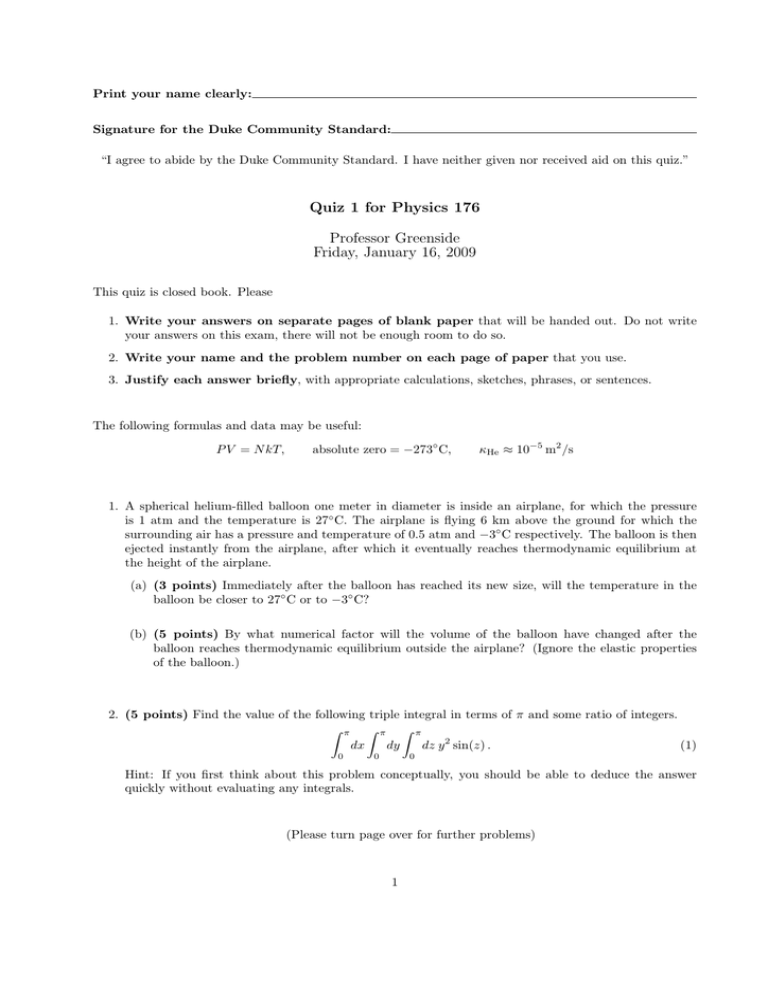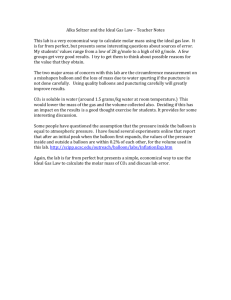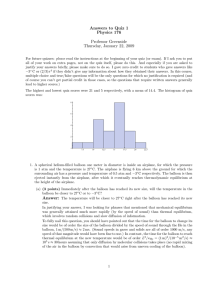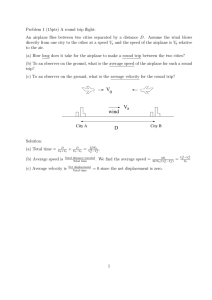Print your name clearly: Signature for the Duke Community Standard:
advertisement

Print your name clearly:
Signature for the Duke Community Standard:
“I agree to abide by the Duke Community Standard. I have neither given nor received aid on this quiz.”
Quiz 1 for Physics 176
Professor Greenside
Friday, January 16, 2009
This quiz is closed book. Please
1. Write your answers on separate pages of blank paper that will be handed out. Do not write
your answers on this exam, there will not be enough room to do so.
2. Write your name and the problem number on each page of paper that you use.
3. Justify each answer briefly, with appropriate calculations, sketches, phrases, or sentences.
The following formulas and data may be useful:
P V = N kT,
absolute zero = −273◦ C,
κHe ≈ 10−5 m2 /s
1. A spherical helium-filled balloon one meter in diameter is inside an airplane, for which the pressure
is 1 atm and the temperature is 27◦ C. The airplane is flying 6 km above the ground for which the
surrounding air has a pressure and temperature of 0.5 atm and −3◦ C respectively. The balloon is then
ejected instantly from the airplane, after which it eventually reaches thermodynamic equilibrium at
the height of the airplane.
(a) (3 points) Immediately after the balloon has reached its new size, will the temperature in the
balloon be closer to 27◦ C or to −3◦ C?
(b) (5 points) By what numerical factor will the volume of the balloon have changed after the
balloon reaches thermodynamic equilibrium outside the airplane? (Ignore the elastic properties
of the balloon.)
2. (5 points) Find the value of the following triple integral in terms of π and some ratio of integers.
Z π Z π Z π
dx
dy
dz y 2 sin(z) .
(1)
0
0
0
Hint: If you first think about this problem conceptually, you should be able to deduce the answer
quickly without evaluating any integrals.
(Please turn page over for further problems)
1
3. (5 points) If the following Mathematica code is executed:
x = Table[ i^2 , {i,1,3} ]
y = x[[2]] x[[3]]
what is the value of the variable y?
4. (5 points) A pot of water is brought to a steady boil on a stove and then a thin plastic cup of room
temperature water is suspended in the middle of the boiling water as shown in the figure below.
Explain whether or not the water in the cup will start to boil if you wait long enough.
Note: In thinking about this problem, keep in mind that it takes energy to convert water to steam.
2










